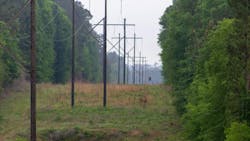Unlocking the Potential of Rights-of-Way Corridors through Integrated Vegetation Management
Rights-of-way (ROWs), those often-overlooked corridors stretching across landscapes, are more than just strips of land. They are critical arteries for energy transmission, transportation and communication. However, uncontrolled vegetation can pose risks, including power outages, infrastructure damage, wildfire hazards, public safety concerns and travel obstructions within the ROW corridor. Integration vegetation management (IVM) can mitigate these risks and unlock the full potential of these corridors.
Historically, vegetation management often relied on reactive, blanket approaches to activities such as pruning, mowing or herbicide applications, often with time-based maintenance intervals. This is not optimal from a cost, efficiency or environmental perspective. IVM, in contrast, takes a proactive, holistic approach, integrating various control methods tailored to specific site conditions and vegetation types. This involves a comprehensive understanding of the ecosystem, including soil composition, climate and the life cycles of target species.
Creating Awareness of Risks
Risk awareness is a key aspect of IVM, helping address the potential risks consequences of uncontrolled vegetation. For energy companies, encroaching trees can lead to potential issues such as power outages and equipment damage, which can impact reliability and cause significant financial losses. For transportation agencies, overgrown vegetation can obstruct visibility, creating potential safety hazards. In wildfire-prone areas, dense vegetation can increase the risk of fires.
Recognizing the ROW as an asset is crucial for securing the necessary investment in effective management. Rather than viewing vegetation control as a mere expense, stakeholders must understand its long-term value. A well-managed ROW enhances infrastructure reliability, reduces maintenance costs, minimizes environmental impact and decreases risk. This asset-based approach to ROW management helps justify the investment in advanced technologies and skilled personnel needed to maintain them.
Tools, Tech and Talent: The Pillars of Modern IVM
Modern IVM relies on a combination of cutting-edge technology, specialized tools and the expertise of skilled foresters and arborists.
- Technology: Remote sensing, including LiDAR and aerial imagery, provides detailed information about vegetation density, height and species composition. Geographic Information Systems (GIS) enable the integration of this data with infrastructure maps, soil surveys and other relevant information.
- Tools: Specialized equipment, such as forestry mulchers, brush cutters and targeted herbicide application systems, allow for precise and efficient vegetation control. Drones equipped with high-resolution cameras and sensors are used for inspections and monitoring. Predictive modeling tools can forecast vegetation growth and identify high-risk areas. Artificial intelligence (AI) and machine learning algorithms are being used to automate vegetation identification and optimize treatment prescriptions.
- Talent: Skilled foresters and arborists possess the knowledge and expertise to develop and implement effective IVM strategies. They understand the complex interactions between vegetation, infrastructure and the environment. They can interpret data, assess risks and prescribe appropriate treatments.
Optimizing Work Prescriptions with Tech-Driven Insights
The integration of technology allows for the optimization of work prescriptions, ensuring that the right treatment is applied at the right time and in the right place. For example, LiDAR data can be used to identify areas with tall trees that can pose a potential risk to surrounding power lines. This information can then be used to prioritize pruning or removal efforts. Similarly, GIS data can be used to map sensitive environmental areas, allowing for the selection of environmentally friendly control methods.
By leveraging these technologies, ROW managers can move away from blanket treatments and towards targeted interventions, minimizing costs and environmental impact. This precision allows for the prioritization of high-risk areas, ensuring that resources are allocated effectively.
Evolving KPIs for a Sophisticated Approach
Traditional key performance indicators (KPIs) for vegetation management often focus on simple metrics, such as the number of miles treated or the amount of herbicide applied. However, these metrics fail to capture the complexity and effectiveness of modern IVM. KPIs should evolve to reflect the sophisticated calculations and data-driven decisions that underpin effective vegetation management. This includes:
- Risk reduction: Measuring the reduction in potential power outages, infrastructure damage and wildfire risk.
- Environmental impact: Assessing the impact of vegetation management practices on soil health, water quality and biodiversity.
- Cost-effectiveness: Evaluating the efficiency of different control methods and the return on investment. Understand costs over time for prescriptions or the program cost benefit.
- Vegetation health: Monitoring the health and diversity of desired plant communities. Gain awareness of compatible species instead of only documenting control of incompatible species.
- Predictive maintenance: Tracking the accuracy of predictive models and the effectiveness of proactive interventions. Monetize the value of the customer experience by valuing avoided impacts to service or reliability.
By adopting these more sophisticated KPIs, stakeholders can gain a more accurate understanding of the performance of their IVM programs and make informed decisions about resource allocation.
The transformation of ROWs from liabilities to assets requires a paradigm shift towards IVM, risk awareness and a commitment to investing in technology and talent. By embracing these principles, stakeholders can ensure the reliability and safety of critical infrastructure, minimize environmental impact and unlock the full potential of these valuable corridors.
About the Author
Matt Goff
Matt Goff ([email protected]) is the president of the Utility Arborist Association (UAA). He also serves as the manager of forestry and ROWs for Georgia Power. He is a certified UVM professional, an ISA utility specialist and a State of Georgia registered forester and is ISA TRAQ qualified.
